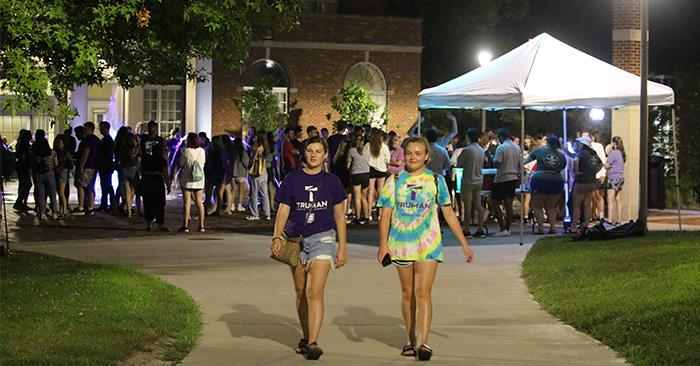New Student Numbers Up to Start the Year

As Truman begins the fall semester, the number of new students on campus increased compared to last year.
The total of first-time freshmen, along with new graduate, transfer and international students, combine to give Truman a 10.4% increase in new students compared to last fall. Official census numbers for the student body will not be available until the fourth week of the semester. Current projections are based on the number of students registered for classes.
Incoming Truman students hail from 24 states and 24 different countries. In total, they represent 366 high schools, where nearly one in five earned a leadership or community service award, and approximately 40% will receive A+ scholarships from the University.
Without the opportunity for regular in-person high school visits and college fairs due to the pandemic, the Admission Office got creative and conducted a number of events virtually, including all University showcases.
“The pandemic has completely upended many norms in higher education. For recruitment, we have had to redesign how we communicate the student experience,” said Ryan Myzak, director of admission. “Rankings and statistics are indicators of quality, but students seek an experience that validates those metrics. With traditional platforms of communicating those – campus visits, large campus events and local outreach in high schools – curtailed or impossible, we have done our best to pivot with outreach in other ways, and we feel prepared for interruptions in the next cycle.”
Truman’s achievement during a challenging time is especially noteworthy considering how difficult recruitment in general has been throughout the Midwest in recent years. According to data from the Coordinating Board for Higher Education, from 2015-2020 every Missouri public four-year institution saw at least one year of negative enrollment growth, with most experiencing the trend for multiple years. In total, 10 of the 13 state universities have seen an overall decrease in enrollment during that time. Stagnant high school graduation numbers are the root of the issue. While the state experienced an increase of an additional 10,000 graduates in the 2009-10 academic year compared to the 2000-01 academic year, the number of high school graduates in Missouri remained fairly flat for the following decade. The same trend is true for the Midwest region overall. While more than 73,000 additional students graduated from Midwest high schools in the 2009-10 academic year compared to 2000-01, the total remained sluggish during the following 10 years. Projections for the state and the region show signs of drastic decreases for the next 15 years.
To offset demographic challenges, Truman has implemented a varied approach in terms of recruitment. The Division of Enrollment Management was expanded to become Enrollment Management and Marketing, with proactive recruitment measures conducted in collaboration with the Admission Office. Along with a new director of admission, the University added a coordinator of marketing position, as well as a director of retention to support students even after they are enrolled.
For the coming year, Truman will continue to pilot its test-optional admission policy. The College Board and the ACT report test-taking declines of more than 60%, and continuing the pilot program is necessary for Truman to be a competitive option for applicants. Most of the highly selective liberal arts colleges have pioneered a holistic, test-optional admission process for more than a decade.
“Truman has always used a holistic review for applications,” Myzak said. “By including a test-optional path to admission, Truman is meeting many students where they are. The review process still evaluates prospective students for academic preparedness, while at the same time allowing those who cannot or chose not to take traditional standardized tests an avenue to gain admission based on other strengths.”
Another positive sign for future recruitment efforts came this year in the form of summer academy enrollment. Truman hosted students for the Joseph Baldwin Academy (JBA), JBA Jr. and the ATSU-Truman Healthcare Academy. Last year, JBA transitioned to an online format, and the other summer academies were suspended altogether. This year, all three programs saw participation levels at or exceeding pre-pandemic numbers. As JBA is an effective feeder program for eventual Truman students, the increase in enrollment shows promise for future entering classes.
Truman also increased its focus on graduate and transfer students, primarily through online marketing. Increases in both areas are a good sign as piloted aspects of those recruitment strategies are incorporated to include undergraduate students in the coming year. Since the University’s recent graduating classes were quite large, total headcount for the current year is down, however, Truman is prepared for long-term growth by increasing the freshmen, transfer, international and graduate student populations.
“We have the best product in the state when it comes to higher education,” said Tyana Lange, vice president for enrollment management and marketing. “In every measurable way, we see that a Truman education is second to none, whether it is graduation rates, alumni career satisfaction, affordability, faculty engagement or any other mark of success. Now that we have developed a new, sustainable infrastructure of recruitment, and are getting it in place, we can position Truman to be successful in spite of any challenges we might face.”
Applications for the 2022-23 school year are already open and can be found at truman.edu/admission-cost/apply-to-truman. Anyone who would like refer a prospective student to Truman can do so at truman.edu/alumni-donors/refer-a-student.
